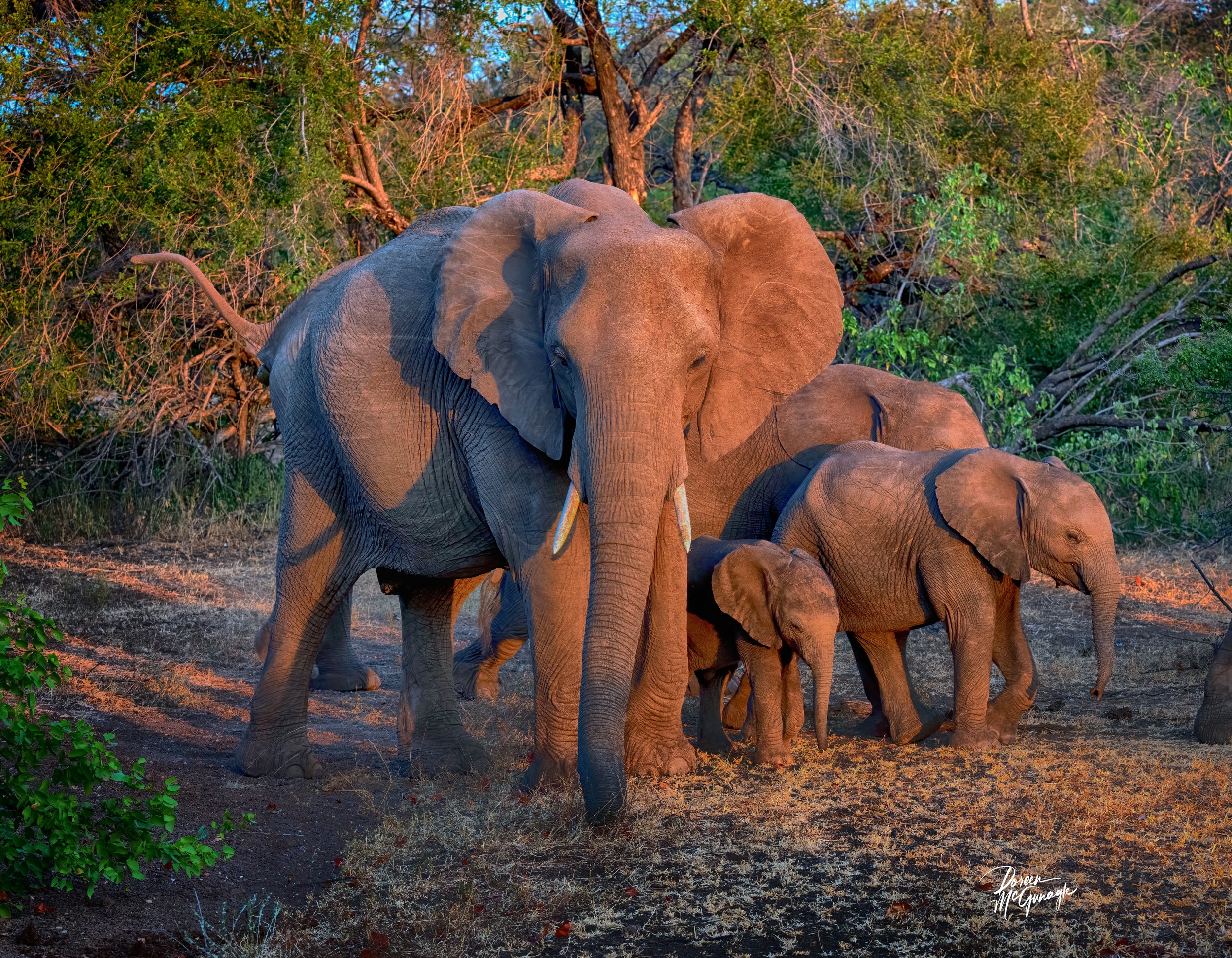Capturing the Majesty: Elephant Photography
Elephants are majestic creatures. Their unparalleled grandeur and grace make them a fascinating subject for photographers.
Majestic Giants of Botswana
Experience the beauty and grace of Majestic Giants of Botswana, a breathtaking photograph capturing the essence of wildlife in their natural habitat.
Large Wall Art Limited Edition 20
Botswana 2983-90 c2024 | Africa | Learn more
Yet, capturing their essence through a lens is no easy task. It requires patience, understanding, and a keen eye for detail.
In this guide, we delve into the art of elephant photography. We'll explore how to capture the beauty of these magnificent animals in their natural habitat.
We'll discuss the importance of understanding elephant behavior for better photos and provide tips on choosing the right gear and timing your shots for optimal results.
Moreover, we'll touch upon the ethical considerations of wildlife photography. Lastly, we'll highlight how elephant photography plays a crucial role in conservation efforts.
Whether you're an amateur photographer or a seasoned professional, this guide will equip you with the knowledge to take your elephant photography to the next level.
Understanding Elephant Behavior for Better Photos
Understanding elephant behavior is key to capturing engaging photos. Elephants are social animals, often seen in herds.
Enduring Bonds: Echoes of Protection
"Enduring Bonds: Echoes of Protection" is a captivating photograph that captures a tender moment between an adult elephant and its calf ambling alongside a serene body of water.
Large Wall Art Limited Edition 20
Botswana 3490-206 c2024 | Africa | Learn More
Observing their interactions can provide unique photo opportunities. For instance, capturing a playful calf or a protective mother can tell a compelling story.
Elephants also exhibit unique behaviors, such as mud-bathing or trunk-twisting. Capturing these moments can add a dynamic element to your photos.
Remember, patience is crucial in wildlife photography. Wait for the perfect shot, and you'll be rewarded with a photo that truly captures the majesty of these magnificent creatures.
Equipment Essentials: Choosing the Right Gear
A telephoto lens is a must for elephant photography. It allows you to maintain a safe distance while still capturing close-up shots.
Camera settings also play a crucial role. A fast shutter speed can capture sudden movements, while the proper exposure ensures well-lit images.
Remember the importance of gear protection in the field. Backing up photos and safeguarding your equipment is essential.
Lastly, consider the use of drones for unique perspectives. However, be aware of the regulations surrounding their use in wildlife photography.
The Art of Timing: When to Capture Elephant Photos
The best times for elephant photography are early morning and late afternoon. These periods offer optimal lighting conditions.
Weather and seasons also impact elephant behavior. This, in turn, affects your photography opportunities.
Patience is vital in wildlife photography. Waiting for the perfect shot can often yield the most rewarding results.
Remember, the goal is to capture natural and engaging photos. Understanding and respecting the elephants' routines will help achieve this.
Composing the Perfect Elephant Family Photo
Elephant family photos can showcase the social structure and interactions within a herd. Capturing these moments requires a keen eye for detail.
Elephant Family
Large Wall Art Limited Edition 20
Botswana 2983-90 c2024 | Africa | Learn More
Focus on the interactions between the elephants. This can create a narrative within your photo.
Consider the rule of thirds and leading lines when composing your shot. These techniques can guide the viewer's eye through the image.
Remember, the goal is to capture the grandeur of these majestic animals. Incorporating the surrounding landscape can give context to your elephant photos.
Ethical Wildlife Photography Practices
Ethical considerations are crucial in wildlife photography. The welfare of the animals should always come first.
Maintain a safe distance from the elephants. Use a telephoto lens to capture close-up shots without disturbing them.
Avoid actions that may stress or alter the elephants' behavior. Patience is critical to getting the perfect shot if the Elphant is stressed, back away and give them space.
Respect the habitats of the elephants. Avoid causing damage to the environment during your photography sessions.
Remember, the goal is to raise conservation awareness, not harm or disturb the animals.
The Role of Elephant Photography in Conservation
Elephant photography plays a significant role in conservation efforts. It helps to raise awareness about the plight of these majestic creatures.
Photographers can tell the story of elephants through captivating images and highlight the impact of human activities on their habitats.
Photographs can also document unique behaviors and interactions. These images can serve as educational materials for wildlife enthusiasts.
Moreover, elephant photos can influence policy and public opinion. They can inspire people to support conservation initiatives.
Every elephant photo is a call to action—a plea for the protection and preservation of these magnificent animals.
Camera Settings for Capturing Majestic Elephant Images
Capturing the majesty of elephants requires the proper camera settings. A fast shutter speed is crucial to freeze sudden movements.
A telephoto lens can help maintain a safe distance. It allows for close-up shots without disturbing the animal.
Aperture settings can control the depth of field. This can highlight the elephant against its environment.
ISO settings should be adjusted according to lighting conditions. This ensures well-exposed images, even in low light.
Understanding your camera's capabilities is critical. It allows you to adapt to the dynamic nature of wildlife photography.
Overcoming Challenges in Elephant Photography
Elephant photography presents unique challenges. One of them is capturing the texture of an elephant's skin.
Harsh lighting conditions can also be a hurdle. Overcoming this requires an understanding of light and shadow play.
Photographing elephants at night is another challenge. It requires specific equipment and knowledge of low-light photography.
Capturing the bond between mother elephants and their calves can be tricky. Patience and observation are key to capturing these tender moments.
In essence, overcoming these challenges enhances the quality of your elephant photos and contributes to your growth as a wildlife photographer.
Enhancing Elephant Photos with Post-Processing
Post-processing is a vital part of elephant photography. It can enhance the visual appeal of your images.
Color and texture play a significant role in this process. Adjusting these elements can bring out the details in your photos.
Black and white photography can emphasize form and contrast. It can give your elephant images a timeless feel.
Remember, post-processing aims to enhance, not alter, your elephant photos. It should preserve their authenticity.
In conclusion, post-processing is a powerful tool. It can transform your elephant photos from good to great.
Sharing Your Elephant Photography with the World
Sharing your elephant photos can raise awareness for conservation efforts. Social media and photography platforms are great places to start.
Remember to tell a story with your photos. Captions can enhance the impact of your images.
In conclusion, sharing your work can inspire others. It can contribute to the preservation of these majestic creatures.
Explore our online gallery of limited-edition conservation fine art nature photography prints. Join us in celebrating and preserving the beauty of our natural world through our exquisite collection of fine art photography.



